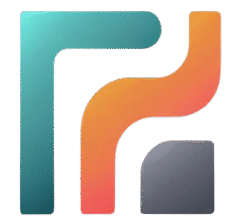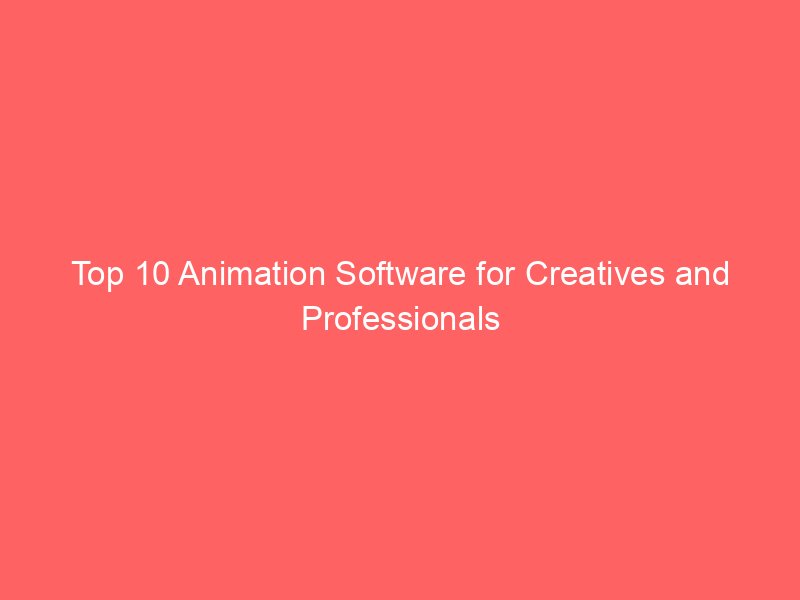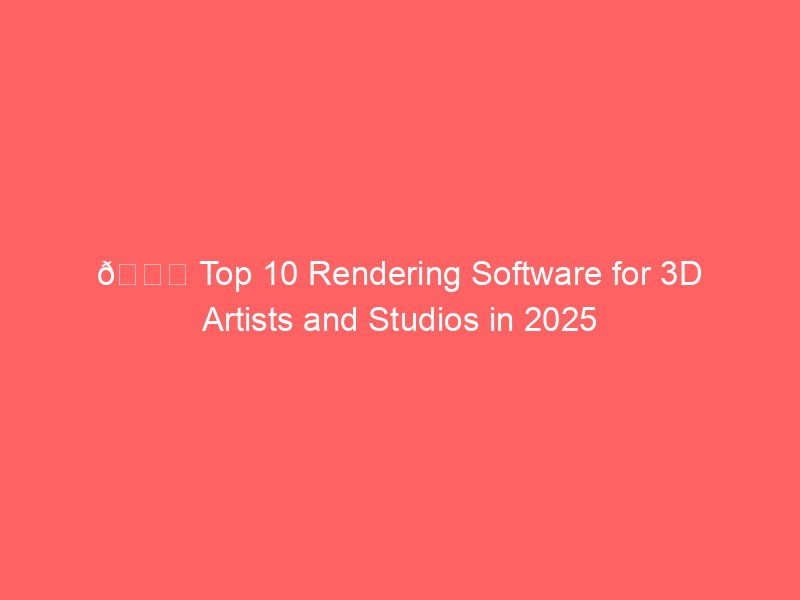Animation has become an integral part of filmmaking, advertising, gaming, education, and even social media content creation. Whether you’re creating a 2D cartoon, a 3D character rig, or a professional animated feature film, the right animation software makes a huge difference in workflow, quality, and speed.
Here’s a detailed look at the 10 best animation software options you can use today.
1. Adobe Animate
Adobe Animate (previously Flash Professional) is a go-to tool for 2D vector animation. It allows artists to create interactive animations for websites, TV shows, and games.
- Key Features:
- Vector-based 2D animation.
- Rigging for character animation.
- HTML5 Canvas support for web deployment.
- Integration with Adobe Creative Cloud.
- Vector-based 2D animation.
- Pros:
- Great for cross-platform publishing.
- Industry standard for web-based animation.
- Smooth integration with Photoshop, Illustrator, and After Effects.
- Great for cross-platform publishing.
- Cons:
- Subscription-based (expensive over time).
- Limited 3D features.
- Subscription-based (expensive over time).
- Best For: Web animators, ad creators, and 2D character designers.
2. Toon Boom Harmony
Used by major studios like Disney and Cartoon Network, Toon Boom Harmony is one of the most powerful tools for 2D animation.
- Key Features:
- Advanced rigging and deformation tools.
- Traditional frame-by-frame drawing support.
- Compositing and effects built in.
- Multi-plane camera support.
- Advanced rigging and deformation tools.
- Pros:
- Studio-grade software.
- Rich library of rigging tools.
- Professional output for broadcast and film.
- Studio-grade software.
- Cons:
- Expensive for individuals.
- Steep learning curve.
- Expensive for individuals.
- Best For: Professional studios, TV series production, feature film animation.
3. Blender
Blender is a free and open-source 3D creation suite with animation, modeling, rendering, and even video editing built in. It’s widely used by indie creators and studios alike.
- Key Features:
- Grease Pencil for 2D animation inside 3D space.
- Rigging and skinning tools for characters.
- Real-time viewport rendering with Eevee.
- Wide community support and plugins.
- Grease Pencil for 2D animation inside 3D space.
- Pros:
- 100% free with no limitations.
- Covers both 2D and 3D animation.
- Constantly updated with new features.
- 100% free with no limitations.
- Cons:
- Interface can overwhelm beginners.
- Steeper workflow compared to paid tools.
- Interface can overwhelm beginners.
- Best For: Indie animators, freelancers, and budget-conscious creators.
4. Autodesk Maya
Maya is one of the most advanced 3D animation software tools used in films, VFX, and games. Major studios rely on Maya for blockbuster animations.
- Key Features:
- Industry-leading rigging and simulation tools.
- Motion capture data integration.
- Arnold rendering engine.
- Extensive scripting (Python, MEL).
- Industry-leading rigging and simulation tools.
- Pros:
- Hollywood-standard toolset.
- Unmatched realism in animation.
- Highly flexible with plugins and scripts.
- Hollywood-standard toolset.
- Cons:
- Extremely expensive.
- Complex learning curve.
- Extremely expensive.
- Best For: Professional animators, VFX houses, AAA game developers.
5. Cinema 4D
Cinema 4D is known for its motion graphics and ease of use compared to other 3D tools. It’s popular in advertising and design studios.
- Key Features:
- Powerful MoGraph toolset.
- Fast rendering with Redshift integration.
- Easy-to-learn UI.
- Great support for After Effects.
- Powerful MoGraph toolset.
- Pros:
- Smooth learning curve for 3D beginners.
- Excellent for motion graphics.
- Strong rendering capabilities.
- Smooth learning curve for 3D beginners.
- Cons:
- Less advanced for character animation.
- Pricey subscription.
- Less advanced for character animation.
- Best For: Motion graphic designers, ad agencies, creative studios.
6. Moho (Anime Studio)
Moho is a dedicated 2D animation software blending vector tools and bone rigging for smooth workflows.
- Key Features:
- Smart bones for advanced rigging.
- Vector-based drawing tools.
- Physics and particle effects.
- Timeline-based animation system.
- Smart bones for advanced rigging.
- Pros:
- Affordable compared to Toon Boom.
- Great for both beginners and pros.
- Fast rigging system saves time.
- Affordable compared to Toon Boom.
- Cons:
- Smaller ecosystem compared to Toon Boom.
- Less adoption in big studios.
- Smaller ecosystem compared to Toon Boom.
- Best For: Indie animators, YouTube creators, and small studios.
7. OpenToonz
OpenToonz is an open-source 2D animation software derived from Toonz (used by Studio Ghibli).
- Key Features:
- Frame-by-frame and rigged animation support.
- Effects and compositing tools.
- Raster and vector drawing capabilities.
- Plugins for custom workflows.
- Frame-by-frame and rigged animation support.
- Pros:
- Free to use.
- Used in professional settings (e.g., Ghibli films).
- Flexible for both beginners and pros.
- Free to use.
- Cons:
- Interface feels outdated.
- Not as polished as paid tools.
- Interface feels outdated.
- Best For: Hobbyists, students, indie creators.
8. TVPaint Animation
TVPaint is a bitmap-based 2D animation tool favored by traditional animators who want a hand-drawn feel.
- Key Features:
- Raster drawing system for natural textures.
- Onion skinning for frame-by-frame.
- Custom brushes.
- Full storyboarding tools.
- Raster drawing system for natural textures.
- Pros:
- Perfect for traditional hand-drawn animation.
- Rich brush customization.
- Studio-grade features.
- Perfect for traditional hand-drawn animation.
- Cons:
- Expensive one-time license.
- Steeper learning curve.
- Expensive one-time license.
- Best For: Artists who want to replicate paper-based traditional animation digitally.
9. Houdini
Houdini is best known for 3D procedural animation and VFX. It’s widely used in blockbuster films for explosions, water simulations, and particle systems.
- Key Features:
- Node-based procedural workflow.
- Powerful physics and particle engine.
- Realistic simulation tools.
- Integration with Unreal and Maya.
- Node-based procedural workflow.
- Pros:
- Best for complex effects like smoke, fire, fluids.
- Extremely flexible for advanced users.
- Industry-standard in VFX.
- Best for complex effects like smoke, fire, fluids.
- Cons:
- Steep learning curve.
- Expensive for freelancers.
- Steep learning curve.
- Best For: VFX artists, technical directors, simulation experts.
10. Synfig Studio
Synfig Studio is a free and open-source 2D animation software designed as an alternative to Flash and Toon Boom.
- Key Features:
- Vector-based animation.
- Bone rigging system.
- Automatic tweening between frames.
- Cross-platform (Windows, macOS, Linux).
- Vector-based animation.
- Pros:
- 100% free.
- Lightweight and beginner-friendly.
- Good for simple 2D projects.
- 100% free.
- Cons:
- Limited compared to Toon Boom or Moho.
- Smaller community support.
- Limited compared to Toon Boom or Moho.
- Best For: Beginners, educators, indie animators.
Final Thoughts
Animation software varies widely depending on whether you want 2D vs. 3D, traditional vs. digital, or professional vs. hobbyist workflows.
- For 2D professionals: Toon Boom Harmony and TVPaint.
- For 3D professionals: Autodesk Maya, Blender, Houdini.
- For motion graphics: Cinema 4D.
- For indie creators: Blender, OpenToonz, Moho, Synfig.
The best tool depends on your project scale, budget, and preferred workflow.





